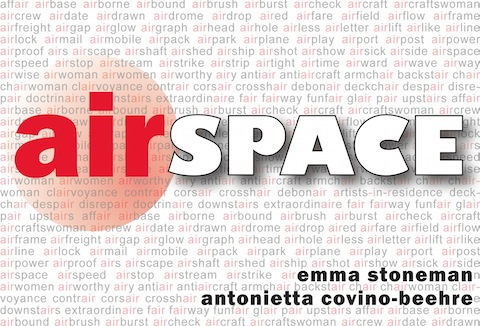
airSPACE
Antonietta Covino Beehre & Emma Stoneman
The Arts Academy, University of Ballarat (UB) has run a very successful Artist in Residence (AIR) program for last eight years. airSPACE is the culmination of recent residencies for Emma Stoneman and Antonietta Covino-Beehre.
The AIR program is an essential and integral element in the fabric of the Visual Arts program and contributes in a practical and vicarious manner to the lifelong learning of students.
Although Stoneman and Covino-Beehre both have links to UB [Stoneman as an graduate and Covino-Beehre as a current sessional lecturer] it was their respective professionalism that inspired senior staff to invite the artists to participate in the AIR program. Students this year have had the privileged opportunity to quietly observe and absorb the conceptual and applied methodology of both artists as they formulated and produced works for a number of exhibitions during their tenure.
Stoneman exhibited in the Ballarat Foto Biennale and Covino-Beehre has had a work acquired by the National Gallery of Australia via the prestigious Silk Cut Foundation Collection Award.
While Stoneman and Covino-Beehre have extensive experience in printmaking, both artists have deviated and meandered across a number of artistic media disciplines including installation, sculpture and photography. Their healthy and exciting cross-disciplinary approach has been keenly acknowledged by observant students.
Juggling and time managing the complexities of family, paid employment and an intensive art practice is increasingly the lot of the contemporary artist - a reality shared by both artists and one which has been successfully accomplished as the work in airSPACE will attest.
On one level there may not appear to be any congruence of aesthetic or conceptual concerns shared by the artists, however with a closer, more considered examination, a range of similarities will present themselves to the astute viewer - a fact not lost on the artists themselves. The human condition with all its frailties, intricacies and anxieties afford a wellspring of stimuli and parallel concerns for both Stoneman and Covino-Beehre.
A spinal injury incurred by Stoneman in her formative years and the continuing management of this has long provided the kernel of an ongoing investigation into the relationship between the organic human skeletal framework and the exacting certitude of man-made architecture.
Throughout history, architects, artists and designers have derived inspiration from the human body. The Bauhaus Building - Prellerhaus in Dessau, Germany and designed by architect Walter Gropius in 1926, is but one example of Stoneman developing photographic imagery and creative sustenance from a broad range of sources.
Over the course of this residency, x-ray and MRI imagery (sourced from Stoneman’s personal medical records) has also provided explorations into postural alignment and anatomical structure not dissimilar to the built environment.
Humans have always erected, constructed and fabricated gravity defying structures for spiritual, domestic and a range of other activities. Buildings can be seen as analogous to vessels for human activity and the boy as a receptacle for the human spirit and consciousness. Entomology also supplies a point of reference. On a micro level, the delicate veins that support the diaphanous cladding of a dragonfly’s wing are replicated on a macro level in contemporary architecture by the use of steel sub structures and light weight weather resistant casings. Entomology, architecture and the human condition
may seem at odds with each other and paradoxical but Stoneman’s photographic images are essentially that, steeped in visual contradiction, metaphor and analogy.
The work exudes a brittle, delicate, poetic sensibility that is contrary to its source but enhanced by formal aesthetic considerations such as colour, tone and composition.
The use of the grid and repetition are also employed extensively by Covino-Beehre for many of the works in this exhibition. Drawing on her Italian heritage, memory, nostalgia and respect for the antiquated object have fuelled the core inspiration for the conceptual and visual element of the prints. Covino-Beehre has recycled many of the traditional embroidery and tapestry designs dating from the 16th Century that were reproduced by her mother. These designs have been skilfully interwoven with iconic Australian and personal imagery. This imagery is highly reverent of the past but also acknowledges
the global position of contemporary art in the digital era.
The physical materiality of the art work produced is an equal imperative to Covino-Beehre. Relief printing on plywood timber panels provides a connection to her cultural background as well as a poignant nostalgic reminder of fading memory and myth.
The children’s novel The Adventures of Pinocchio (1883), by the Italian writer Carlo Collodi, supplies visual and metaphoric references for Covino-Beehre. Pinocchio has been widely acknowledged as an iconic character of contemporary culture and one of the most reimagined characters in the pantheon of children’s literature. Included in this exhibition is a striking mono-chromatic image of Pinocchio’s head which is shown layered behind a lace inspired grid matrix. This juxtaposition of the character with the hand crafted overlay signifies the paradoxical human foibles that Pinocchio possesses.
Drawing on the work of Rosalind Krauss, the well-known American art critic and theorist, Covino-Beehre argues that using a grid makes it possible for artists to deal with the surface and depth simultaneously. This permits a focus on the materiality of objects and speaks to the pure essence of the work while at the same time implying a connection to ideas of spirit and “Being.”
This notion of “spirit and being” offers a galvanising linkage between Stoneman and Covino-Beehre and their art. Through the shared experience of the Artist in Residency Program they have developed a strong personal bond and friendship, one built upon professional commitment and mutual respect.
The Arts Academy, staff and students are indeed fortunate to have shared in this journey and the resultant exhibition airSPACE.
Peter Pilven
November 2013